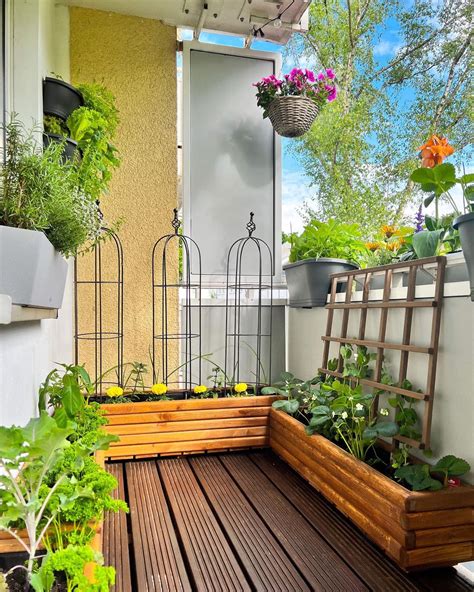Creating the Perfect Balcony Garden for Ultimate Relaxation
In urban environments, outdoor spaces are often limited, but a well-designed balcony garden can offer a peaceful retreat right outside your door. Whether you’re a gardening novice or an expert, designing a balcony garden focused on relaxation involves careful planning, strategic plant selection, and thoughtful use of space. This guide will walk you through key concepts, provide practical tips, and explore various strategies for creating a serene garden in a limited area.
Key Concepts of Balcony Garden Design for Relaxation
- Space Utilization: Maximize your limited balcony area by incorporating vertical elements and multi-functional furniture.
- Plant Selection: Choose greenery that not only thrives in your climate but also contributes to the calming atmosphere.
- Comfort and Aesthetics: Opt for soothing colors, comfortable seating, and accessories that enhance relaxation.
- Maintenance Level: Consider how much time you can devote to garden upkeep, and select plants accordingly.
Historical Context of Urban Balcony Gardens
The concept of balcony gardens is not new. As far back as ancient Rome, wealthy citizens cultivated small green spaces on their terraces to enjoy nature within city limits. In modern times, urban gardening has grown in popularity due to increasing urbanization and the need for personal green spaces. Historically, balcony gardens have shifted from being purely ornamental to serving functional and environmental purposes, such as food production and improving air quality.
Current State of Balcony Garden Design
Today, balcony gardens are used to create a refuge in bustling cities. With space constraints, urban gardeners are innovating with container gardening, vertical gardens, and modular setups. The rise of eco-consciousness has also driven interest in sustainable gardening practices. People now look to grow their own herbs, vegetables, and flowers in smaller, more versatile garden setups.
Practical Applications of Balcony Gardens
To transform a small balcony into a tranquil outdoor space, you’ll need to balance form and function. Here are some practical gardening tips:
- Container Gardening: Choose pots or planters that fit your balcony’s dimensions. Lightweight, durable materials like fiberglass or plastic work well in small spaces.
- Plant Selection: Opt for low-maintenance plants that provide lush greenery and soothe the senses. Consider succulents, ferns, and hanging plants.
- Water Features: Even a small fountain can add a soothing element through the gentle sound of running water.
- Lighting: Use soft, ambient lighting such as string lights or solar-powered lanterns to create a peaceful evening atmosphere.
- Comfortable Seating: Incorporate weather-resistant cushions or hammocks to promote relaxation and leisure time outdoors.
Case Studies of Successful Balcony Gardens
| Case Study | Location | Design Elements | Outcome |
|---|---|---|---|
| Zen-Inspired Balcony Retreat | New York City, NY | Bamboo plants, pebbles, and a small fountain | A calm, minimalist space ideal for meditation |
| Vertical Green Wall in a Small Balcony | San Francisco, CA | Succulents and vertical trellis for climbing plants | Maximized space with lush greenery |
| Herb Garden for Relaxation and Cooking | Chicago, IL | Container garden with basil, rosemary, and thyme | Functional and relaxing with aromatic herbs |
Stakeholder Analysis
- Homeowners: Seek a balance between aesthetics, relaxation, and functionality in their outdoor spaces.
- Landlords: Often concerned with the weight limits and overall impact on the property’s structure and appearance.
- Urban Planners: Interested in the broader environmental benefits, such as improved air quality and biodiversity in dense urban areas.
Implementation Guidelines for Your Balcony Garden
- Assess Space and Light Conditions: Measure your balcony and determine how much sunlight it gets throughout the day.
- Choose the Right Plants: If your balcony gets plenty of sunlight, opt for sun-loving plants like lavender or rosemary. Shadier spots are better suited for ferns or peace lilies.
- Select Functional Furniture: Opt for foldable or stackable furniture that provides comfort but doesn’t overwhelm the space.
- Incorporate Soothing Elements: Add elements like wind chimes or water features to enhance the relaxing atmosphere.
- Think Vertically: Use wall-mounted planters or trellises to maximize space for plants and decorations.
Ethical Considerations in Balcony Garden Design
While balcony gardens offer personal benefits, they also have broader implications. Some considerations include:
- Sustainability: Ensure the materials used are eco-friendly, such as recycled containers or organic soils.
- Water Usage: Opt for water-efficient plants or drip irrigation systems to minimize waste.
- Wildlife Impact: Create a garden that attracts pollinators like bees and butterflies, contributing to local biodiversity.
Limitations and Future Research
Balcony gardens come with several limitations. Structural concerns, such as the weight capacity of your balcony, limit what can be installed. Additionally, urban environments may have restrictions related to water usage or plant species. Future research may explore ways to optimize urban gardening for environmental sustainability and scalability, particularly in larger cities with less outdoor space per person.
Expert Commentary on Balcony Gardens
Designing a balcony garden can be both rewarding and challenging. Experts agree that understanding your specific space limitations and climatic conditions is key. “The key to success,” says urban gardening expert Jane Smith, “is in choosing the right plants that thrive in limited spaces while also creating an inviting environment that encourages relaxation.” Other experts emphasize the importance of sustainability, particularly in cities where water and space are at a premium. A well-executed balcony garden not only enhances personal well-being but also contributes to the greater environmental ecosystem by encouraging biodiversity and promoting mental health through exposure to nature.


